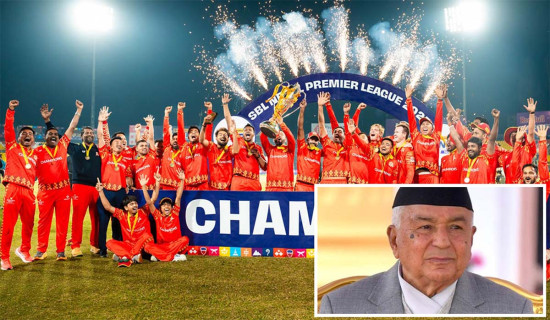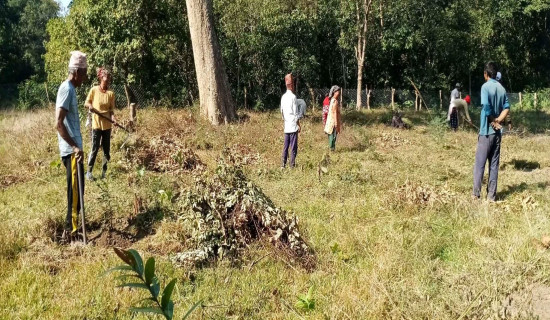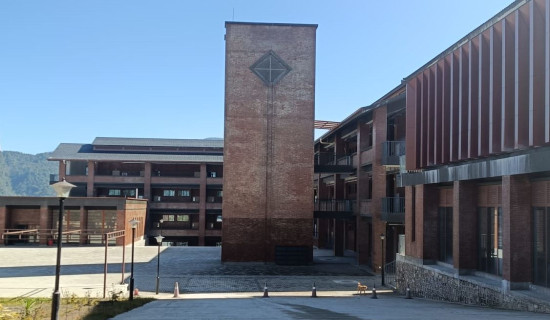- Sunday, 14 December 2025
Pay Heed To Cultural Democracy
Nepal is a country of cultural specificity. The rich and diverse culture is a matter of pride. It is the most important common asset that has promoted unity and created identity. Whether it is in people's behaviour or reflection in the images and heritages, culture is not only binding us but also reminding us how our ancestors lived and celebrated. Culture is a means of civilizational sustainability. It also gives impetus to social and religious tolerance, which nurtures harmony. Many communities are valuing culture, while others are fading into oblivion. But are we up to the mark to understand cultural values and study them from a broader perspective?
Similarly, what is democracy? What is it for? It is a system where political parties, freedoms, elections, and governments are prioritised, or it needs more for a broader ambit and acceptability. Inclusion and marginalisation are paid heed to or just kept aloof from the mainstream. What is our democracy, and how is it being dealt with? Can democracy be a cultural space or not? Inadequate study and research, narrow understanding of democracy and nationalism, overriding politics, assault on academic and university significance, sheer ignorance of culture, and tantra are some of the issues raised vocally in the book 'Sanskriti Chintan' (Musing on Culture), penned by Professor Arun Gupto. It is a compendium of meditative essays. However, there are a few interviews as well.
An ardent reader of philosophy and non-western study, professor Gupto is equally a keen observer of culture in South Asia. The book not only depicts cultural specificities but also shows the writer's immersion in the culture so that even the nuances are traced out.
Despite being a voracious reader, his frank admission of a new arena and his need for more knowledge on it is a unique style Gupto adopts while touching upon some issues. He candidly informs the readers that he wants to do further research and share it in the future. It can be interpreted as a writer's style of sticking readers to his genuine research so that his further books will not be missed.
Gupto's thoughts encourage everyone to be a critical thinker rather than adhering to anything naively. The need to reconsider what you read and see is another urge that will be whetted by critical thinking. From democracy to tantra, goddess to 'gundruk' and 'thekuwa', nationalism to post-colonialism, and culture to the Maoist revolution, the meditative essays are boosters to enable discourse on these fronts.
The writer's fascination with Devis
(goddesses) and ancient art may sound idiosyncratic for some, as the present world is craving after the materialistic world and philistine pleasure where they find meaning in other things.
Contradiction in character, inconsistency, and the dynamism of diversity are more important than the form of Devi Durga for the writer. Several features, including awakening, kindness, yearning, reverence, radiance, reminiscence, torpor, potency, etc., are found in the Devi Durga. He also writes Sankrit rhymes on it, like "Ya Devi Sarbavuteshu Bishnumayeti Shabdita/Namastassai Namastassai Namastassai Namonama." On art and democracy, he writes, "The Malla era arts can be observed as examples of artistic sensitivity. The Malla-era arts had created a vibe then. Temples, devotional initiations, and paintings are other examples of art. These places were not mere religious places, and they are not either. These places are 'secular space'."
He reminds us to observe Hanuman Dhoka Square as a secular and free space. Gupto pities the blatant absence of culture and art in democracy. Isn't it necessary for us Nepalis as well to ponder over this? "Democracy should not be limited to political science but warrants a blend of art. It is not essential to depend on definitions all determined by the West. Although Western democracy has done well in areas from philosophy to administration, we can also find definitions of democracy at our convenience."
With this, Professor Gupto's suggestion reiterates the need for further research on what we have and how we are benefiting from our cultural facilities. This said, he, however, does not belittle any narrative but inspires thinking outside the box.
Professors see denial of science and incumbency through elections as grave threats to democracy in the world at present, which many political observers and social scientists have also underlined.
Colonised thoughts of democracy and nationalism are exposed by the writer. He argues that the South Asian subcontinent was a cultural space. Once European colonialism gripped most of the countries in this region, political nationalism got entry here. He loves cultural nationalism, asserting that it is broader. "Attributes to nationalism go to Europe. South Asia did not have such feelings.
It was a cultural land in deed. Once Europe colonised India and other countries in the 19th century, it foisted political nationalism on its colonies. It has both positive and negative aspects" (Pg. 168). Although the writer views culture as plural, while nationality inclines to singularity, he does not fully negate nationalism.
Avid reading of myths is another salient feature of the book. The author draws meaning from myths. Myths are essential parts of life and learning.
Pondering over hero, anti-hero, villain, antagonist, protagonist, celebrity, and statesman arrests substantive attention. The writer expresses worry over the society that runs after celebrities and idealises such figures, while society has to undergo severe pangs to produce a statesman. The birth of a statesman is linked to revolution and charisma. "A protagonist has emerged from contradictory evolution," he views. According to him, mythical anti-heroes struggle with gods for power." Satan in Christianity and Mahisasur in Hinduism are mythical anti-heroes. They bear the story of death that crumbles one's heart."
Similarly, on celebrity, he views, "Celebrity can have influence in any sector. He or she has huge followers on social media. But he or she does not have yearning for epoch-making change and cannot have either" (Pg. 51).
The writer has given an interview to an essayist, where he brings references to antagonists ranging from mythical texts to English and Nepali literature. He also makes comparisons and contrasts among Suyogbir of the Sirishko Phul and characters like Iago and Macbeth in Shakespeare's dramas.
Similarly, with an allusion to a Mesopotamian folktale, the writer has finely shed light on the inseparability of love and hatred. The book, written in Nepali, is published by Indigo Ink. It is a seminal read for discourses on contemporary issues ranging from culture to democracy. It costs Rs. 499.

















